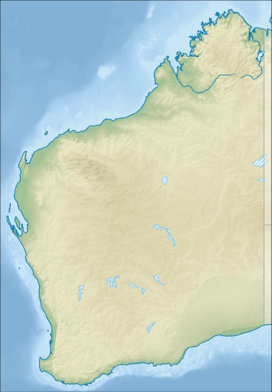Tathra National Park
| Tathra National Park Western Australia | |
|---|---|
|
IUCN category II (national park) | |
|
| |
 Tathra National Park | |
| Nearest town or city | Eneabba |
| Coordinates | 29°46′37″S 115°31′44″E / 29.77694°S 115.52889°ECoordinates: 29°46′37″S 115°31′44″E / 29.77694°S 115.52889°E |
| Established | 1970 |
| Area | 43.22 km2 (16.7 sq mi)[1] |
| Managing authorities | Department of Environment and Conservation (Western Australia) |
| Website | Tathra National Park |
| See also |
List of protected areas of Western Australia |
Tathra National Park is a national park in Western Australia (Australia), located 240 kilometres (149 mi) north of Perth between the towns of Eneabba and Carnamah on Winchester-Eneabba Road. The name is derived from a Noongar word meaning "beautiful place".
Description
The park is set in sandplain country and is surrounded by farmland, somehow having managed to escape clearing by wheat farmers in the early 20th century.[2] Shallow valleys with sandy floors change to laterite on the slopes and hilltops, and the low heath changes in composition accordingly. The park is considered a representative sample of flora of the area, although includes some unusual plants - including a species of Daviesia notable for its large red flowers, which is known only from the reserve, and Shaggy Dryandra (Banksia splendida) which is common on some lateritic rises. Public usage of the park was mainly for wildflower observation in winter and spring according to a 1974 report, whose recommendation (which was not followed) would have seen it demoted to a flora and fauna conservation reserve.[3]
History
Land for the national park was set aside by the Department of Lands and Surveys under Reserves ↑26802 and ↑26805 on 23 May 1969, and over 1970 and 1971, the land was classified as an "A" Class reserve, meaning its purpose could not be changed except by an Act of Parliament,[4] and was vested in the National Parks Authority of Western Australia. The park was officially named on 8 October 1971.[5]
See also
References
- ↑ "Department of Environment and Conservation 2009–2010 Annual Report". Department of Environment and Conservation. 2010: 48. ISSN 1835-114X.
- ↑ Fairfax Digital (8 February 2004). "Travel - Eneabba". The Sydney Morning Herald. Retrieved 11 August 2007.
- ↑ Conservation through Reserves Committee (31 January 1975). Conservation Reserves in Western Australia - Report 1974 (Green Book). Environmental Protection Authority of Western Australia. pp. 5–20, 5–21. ISBN 0-7244-5934-0.
- ↑ Jenkins, C. F. H. (Clee) (1980). The National Parks of Western Australia. National Parks Authority of Western Australia. p. 19. ISBN 0-7244-8176-1.
- ↑ "Reserves (per 4024/67, 4025/67)". Western Australia Government Gazette. 23 May 1969. p. 1969:1529. (Reserves 26802 and 26805)
* "Land Act 1933-1969 - Order in Council (per 4024/69)". Western Australia Government Gazette. 10 July 1970. p. 1970:2029. See also 5 February 1971 p. 1971:342.
* "Naming of Tathra National Park (per 2531/54 V2)". Western Australia Government Gazette. 8 October 1971. p. 1971:3952.
External links
![]() Media related to Tathra National Park at Wikimedia Commons
Media related to Tathra National Park at Wikimedia Commons